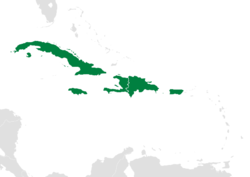Greater Antilles
| Greater Antilles Grandes Antilles (French) Antillas Mayores (Spanish) |
|
|---|---|
| Region of the Caribbean | |
 Location within the Caribbean. |
|
| Island States | |
| Area | |
| • Total | 207,411 km2 (80,081 sq mi) |
| Population (2013) | |
| • Total | 37,582,088 |
| • Density | 169.05/km2 (437.8/sq mi) |
| Demonym(s) | Greater Antillean |
| Time zones | EST: UTC-5/EDT: UTC-4 |
| AST: UTC-4/ADT: UTC-3 | |
The Greater Antilles is a grouping of the larger islands in the Caribbean Sea: Cuba, Hispaniola (containing Haiti and the Dominican Republic), Puerto Rico, Jamaica, and the Cayman Islands.
The Greater Antilles constitute over 90% of the land mass of the entire West Indies, as well as over 90% of its population. The remainder of the land belongs to the archipelago of the Lesser Antilles, which is a chain of islands to the east (running north-south and encompassing the eastern edge of the Caribbean Sea where it meets the Atlantic Ocean) and south (running east-west off the northern coast of South America).
The word Antilles originated in the period before the European conquest of the New World - Europeans used the term Antilia as one of the mysterious lands featured on medieval charts, sometimes as an archipelago, sometimes as continuous land of greater or lesser extent, its location fluctuating in mid-ocean between the Canary Islands and Eurasia.
The Lucayan Archipelago is not considered to be a part of the Antilles archipelagoes but rather of the North Atlantic.
Coordinates: 21°59′N 79°02′W / 21.983°N 79.033°W
...
Wikipedia
